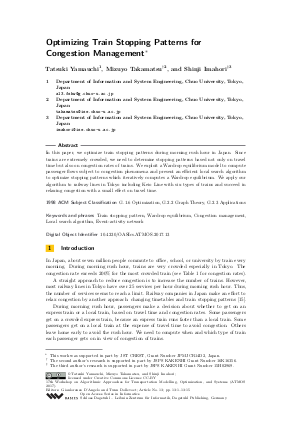Optimizing Train Stopping Patterns for Congestion Management
Authors Tatsuki Yamauchi, Mizuyo Takamatsu, Shinji Imahori
-
Part of:
Volume:
17th Workshop on Algorithmic Approaches for Transportation Modelling, Optimization, and Systems (ATMOS 2017)
Part of: Series: Open Access Series in Informatics (OASIcs)
Part of: Conference: Symposium on Algorithmic Approaches for Transportation Modelling, Optimization, and Systems (ATMOS) - License:
 Creative Commons Attribution 3.0 Unported license
Creative Commons Attribution 3.0 Unported license
- Publication Date: 2017-09-04
File

PDF
OASIcs.ATMOS.2017.13.pdf
- Filesize: 1.93 MB
- 15 pages
Document Identifiers
Subject Classification
Keywords
- Train stopping pattern
- Wardrop equilibrium
- Congestion management
- Local search algorithm
- Event-activity network
Metrics
- Access Statistics
-
Total Accesses (updated on a weekly basis)
0Document
0Metadata
Abstract
In this paper, we optimize train stopping patterns during morning rush hour in Japan. Since trains are extremely crowded, we need to determine stopping patterns based not only on travel time but also on congestion rates of trains. We exploit a Wardrop equilibrium model to compute passenger flows subject to congestion phenomena and present an efficient local search algorithm to optimize stopping patterns which iteratively computes a Wardrop equilibrium. We apply our algorithm to railway lines in Tokyo including Keio Line with six types of trains and succeed in relaxing congestion with a small effect on travel time.
Cite As Get BibTex
Tatsuki Yamauchi, Mizuyo Takamatsu, and Shinji Imahori. Optimizing Train Stopping Patterns for Congestion Management. In 17th Workshop on Algorithmic Approaches for Transportation Modelling, Optimization, and Systems (ATMOS 2017). Open Access Series in Informatics (OASIcs), Volume 59, pp. 13:1-13:15, Schloss Dagstuhl – Leibniz-Zentrum für Informatik (2017)
https://doi.org/10.4230/OASIcs.ATMOS.2017.13
BibTex
@InProceedings{yamauchi_et_al:OASIcs.ATMOS.2017.13,
author = {Yamauchi, Tatsuki and Takamatsu, Mizuyo and Imahori, Shinji},
title = {{Optimizing Train Stopping Patterns for Congestion Management}},
booktitle = {17th Workshop on Algorithmic Approaches for Transportation Modelling, Optimization, and Systems (ATMOS 2017)},
pages = {13:1--13:15},
series = {Open Access Series in Informatics (OASIcs)},
ISBN = {978-3-95977-042-2},
ISSN = {2190-6807},
year = {2017},
volume = {59},
editor = {D'Angelo, Gianlorenzo and Dollevoet, Twan},
publisher = {Schloss Dagstuhl -- Leibniz-Zentrum f{\"u}r Informatik},
address = {Dagstuhl, Germany},
URL = {https://drops.dagstuhl.de/entities/document/10.4230/OASIcs.ATMOS.2017.13},
URN = {urn:nbn:de:0030-drops-78988},
doi = {10.4230/OASIcs.ATMOS.2017.13},
annote = {Keywords: Train stopping pattern, Wardrop equilibrium, Congestion management, Local search algorithm, Event-activity network}
}
Author Details
References
-
M. Beckmann, C. B. McGuire, and C. B. Winsten. Studies in the Economics of Transportation. Yale University Press, New Haven, 1956.

-
Bureau of Public Roads, U.S. Dept. of Commerce, Urban Planning Division, Washington D.C. Traffic assignment manual, 1964.

-
Z. Cao, Z. Yuan, and S. Zhang. Performance analysis of stop-skipping scheduling plans in rail transit under time-dependent demand. International Journal of Environmental Research and Public Health, 13:707: 1-23, 2016.

-
J. J. Cochran, L. A. Cox, Jr., P. Keskinocak, J. P. Kharoufeh, and J. C. Smith, editors. Wiley Encyclopedia of Operations Research and Management Science. John Wiley &Sons, Inc., 2011.

-
M. Florian. Untangling traffic congestion: application of network equilibrium models in transportation planning. OR/MS Today, 26:52-57, 1999.

-
M. Frank and P. Wolfe. An algorithm for quadratic programming. Naval Research Logistics, 3:95-110, 1956.

-
C. Liebchen and R. Möhring. The modeling power of the periodic event scheduling problem: railway timetables and beyond. In Algorithmic methods for railway optimization, volume 4359 of Lecture notes in computer science, pages 3-40, Berlin, 2007. Springer.

-
D.-Y. Lin and Y.-H. Ku. Using genetic algorithms to optimize stopping patterns for passenger rail transportation. Computer-Aided Civil and Infrastructure Engineering, 29:264-278, 2014.

- Transport Ministry of Land, Infrastructure and Tourism. (In Japanese). URL: http://www.mlit.go.jp/common/001099730.pdf.
- Transport Ministry of Land, Infrastructure and Tourism. (In Japanese). URL: http://www.mlit.go.jp/sogoseisaku/transport/sosei_transport_tk_000035.html.
-
M. E. Schmidt. Integrating Routing Decisions in Public Transportation Problems. Springer, New York, 2014.

-
A. Schöbel. Optimization in Public Transportation. Springer, New York, 2006.

-
A. Schöbel. Line planning in public transportation: models and methods. OR spectrum, 34:491-510, 2012.

-
A. Taguchi. Time dependent traffic assignment model for commuter traffic in Tokyo Metropolitan railway network (in Japanese). Transactions of the Operations Research Society of Japan, 48:85-108, 2005.

-
S. Toriumi, Y. Nakamura, and A. Taguchi. A computation model for delay of commuter train (in Japanese). Communications of the Operations Research Society of Japan, 50:409-416, 2005.

-
L. Wang, L. M. Jia, Y. Qin, J. Xu, and W. Mo. A two-layer optimization model for high-speed railway line planning. Journal of Zhejiang University - SCIENCE A, 12:902-912, 2011.

-
Y. Yue, S. Wang, L. Zhou, L. Tong, and M. R. Saat. Optimizing train stopping patterns and schedules for high-speed passenger rail corridors. Transportation Research Part C, 63:126-146, 2016.

